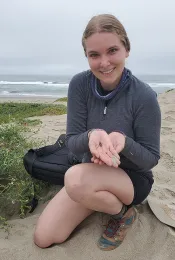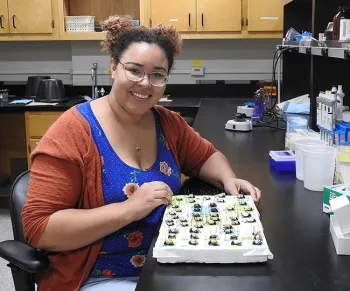
One of the activities at the Bohart Museum of Entomology open house, "Eight-Legged Encounters," set from 1 to 4 p.m., Saturday, June 25, will be a "Name-That-Spider-Species" contest, open to students 18 and under. The focus: a male trapdoor spider, a new species from the genus Promyrmekiaphila.
The event will be co-hosted by the Bohart Museum and the American Arachnological Society (AAS).
The open house will kick off the annual meeting of AAS, which meets June 26-30 on the UC Davis campus, said arachnologist Jason Bond, associate dean, College of Agricultural and Environmental Sciences, and the Evert and Marion Schlinger Endowed Chair in Insect Systematics, UC Davis Department of Entomology and Nematology. Professor Bond is chairing the AAS conference with Lisa Chamberland, postdoctoral research associate of the Bond lab, and Joel Ledford, assistant professor of teaching, Department of Plant Biology, College of Biological Sciences.
Chamberland, who holds a doctorate from the University of Vermont where she studied the historical biogeography of net-casting spiders (Deinopis) and spiny-backed orb-weavers (Gasteracantha) in the Caribbean, is coordinating the spider-species naming project with doctoral student Emma Jochim of the Bond lab and incoming doctoral student Iris Bright, who starts this fall.

"The genus Promyrmekiaphila is a group of trapdoor spiders that construct silk-lined burrows with wafer-like trapdoor lids, usually decorated with plant material or substrate," Jochim explained. "It's found generally in the Southern Bay Area. As of now there are only two species in the genus, so this new species will be the third!"
The student who wins the contest will have the honor of naming the new species, and an acknowledgment will appear in a forthcoming scientific paper, said Bond.
At the open house, some 20 exhibits and activities--educational and entertaining--will be set up in the hallway of the Academic Surge Building. “There will be everything--spider specimens, live arachnids, activities, artwork, etc., at the open house," said Bond, adding that a powerhouse of the nation's arachnologists will participate.
AAS member Eileen Hebets, professor at the University of Nebraska, Lincoln, is co-hosting the open house as part of a U.S. National Science Foundation grant, “Eight-Legged Encounters” that she developed as an outreach project to connect arachnologists with communities, especially youth. She seeks to educate the public “about the wonders of biology and the possibility of scientific discovery using a charismatic and engaging group of animals--arachnids. Arachnids (spiders and their relatives) are ubiquitous, thriving in most habitable environments on our planet (including underwater),” as mentioned on her website, https://hebetslab.unl.edu/eight-legged-encounters.

Professor Bond offers five good reasons to like spiders:
- Spiders consume 400-800 million tons of prey, mostly insects, each year. Humans consume somewhere around 400 million tons of meat and fish each year.
- Spider silk is one of the strongest naturally occurring materials. Spider silk is stronger than steel, stronger and more stretchy than Kevlar; a pencil thick strand of spider silk could be used to stop a Boeing 747 in flight.
- Some spiders are incredibly fast--able to run up to 70 body lengths per second (10X faster than Usain Bolt).
- Although nearly all 47,000-plus spider species have venom used to kill their insect prey, very few actually have venom that is harmful to humans.
- Some spiders are really good parents--wolf spider moms carry their young on their backs until they are ready to strike out on their own; female trapdoor spiders keep their broods safe inside their burrows often longer than one year, and some female jumping spiders even nurse their spiderlings with a protein rich substance comparable to milk.

Hebets says that as a scientist, a mother and an educator, she often sees "the disconnect between youth and the world around them; between problem solving skills, observation skills, critical thinking, natural curiosity and the more traditional formal teaching programs experienced by many students. Youth are innately curious and tremendously creative and my aim is to leverage these traits for their own educational advancements in a fun and engaging manner.” To date, Hebets and her collaborators have developed more than 25 modular activity stations “encompassing arts and crafts, experiments, games, and other hands-on activities." They include classification and taxonomy, spiders and silk, path of predators, and hands-on science.
The Bohart Museum, directed by UC Davis distinguished professor Lynn Kimsey, houses a worldwide collection of eight million insect specimens; a live "petting zoo" (Madagascar hissing cockroaches, stick insects and tarantulas) and an insect-themed gift shop.
In addition to the open house, AAS has scheduled a series of arachnid lectures, free and open to the public, from 7:30 to 9 p.m. Tuesday, June 28, in the newly constructed 600-seat lecture hall, California Hall.

